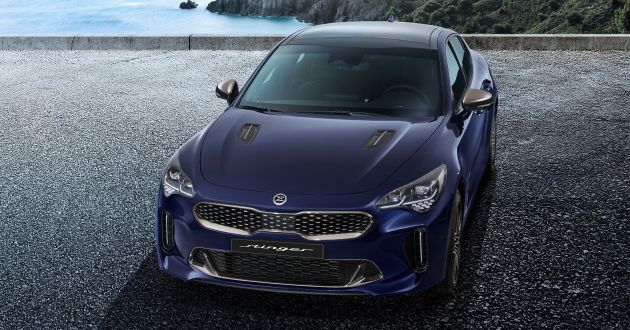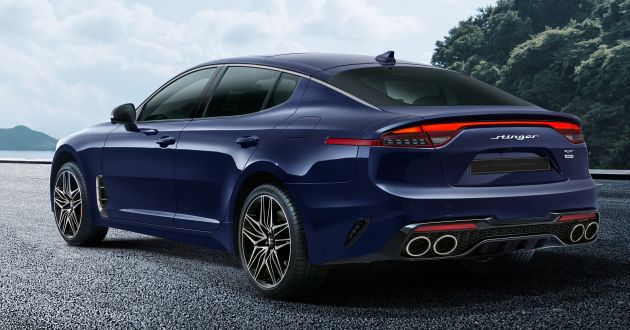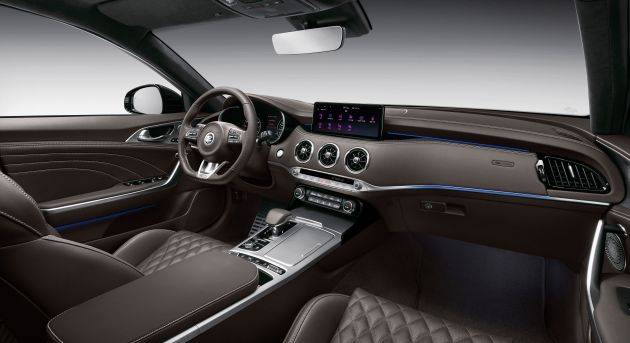After giving us our first look at the facelifted Kia Stinger earlier this month, the Korean carmaker has now released more information of its sporty fastback sedan. Sales of the updated model will begin in Korean during the third quarter of 2020, before rolling out to other global markets later in the year.
Under the bonnet, the Stinger will come with three turbocharged petrol engines, which is one more than before. The new addition is a Smartstream 2.5 litre four-cylinder T-GDi unit that is already in use in the Genesis GV80 and G80, rated at 304 PS at 5,800 rpm and 422 Nm of torque from 1,650 to 4,000 rpm.
Meanwhile, the most powerful option remains the Lambda 3.3 litre twin-turbo V6 T-GDi, which now comes with a new Electronic Variable Exhaust Valve system. According to Kia, this features a small butterfly valve in the exhaust that can be opened or closed to make a more prominent and deeper exhaust note in Sport driving modes.
Alternatively, when you need to take things down a notch in Eco or Comfort modes, a quieter, more subdued exhaust note is made instead. The updated exhaust not only helps in terms of acoustics, but also provides better flow, so you now get an extra 3 PS from the engine. The final figures are 373 PS at 6,000 rpm and 510 Nm from 1,300 to 4,500 rpm. The exhaust is standard on all V6-equipped models except those sold in Europe and Russia, which also means they retain the previous 370 PS output.
At the bottom of the range is the familiar Theta 2.0 litre four-cylinder that has been around since the Stinger arrived in 2017. It remains unchanged with the facelift, producing the same 255 PS at 6,200 rpm and 353 Nm from 1,400 to 4,000 rpm. All three engines are paired with an eight-speed automatic transmission, with either rear- or all-wheel drive, although it isn’t known if the new Smartstream mill gets the latter.
On the inside, the infotainment displays available for the Stinger have been upgraded, with lower-end variants fitted with an eight-inch touchscreen that is an upgrade over the previous seven-inch system. Higher-end Stingers will get an even larger 10.25-inch unit instead, with both supporting wireless Android Auto and Apple CarPlay. The larger option also gets Bluetooth multi-connection, so up to two devices can be connected at the same time, if required.
Besides the central display, Kia also made changes to the instrument cluster, as the previous 3.5-inch mono-TFT display has been replaced with a larger 4.2-inch colour-TFT LCD screen instead. The more expensive variants get a fully-digital seven-inch Supervision cluster that can display a wide array of information.
Depending on the market, there are a variety of new interior colour and material options too. In Korea, there will be a Dark Brown monotone interior with diamond quilted Nappa leather seats, with other global markets receiving the plush leather in Saturn Black, Red and Beige.
Kia says that there’s a Saturn Black package that sees the seats being finished in black suede with red contrast stitching in a “chain” pattern to resemble the links on a watch strap. Also added is a 64-colour ambient lighting system to give the cabin a more upmarket look.
As revealed earlier, the outside of the new Stinger looks largely the same as before, with the biggest revision being the new taillight arrangement around back. This consists of an upper lighting signature that spans the width of the car and conforms to the shape of the subtle spoiler on the boot lid. At the front, the LED headlamps have been altered to sport a new design and LED daytime running lights, while appearing “darker and sleeker with the lights out.”
More powerful Stinger variants have the option of larger wide-bore exhaust mufflers in a bright silver finish, along with a more purposeful rear diffuser. Kia also offers a new exterior colour, along with two new 18- and 19-inch aluminium alloy wheels with “intricate, geometric designs.”
A new option is the Dark Package for high-performance GT variants, which add a gloss black diffuser surround, plus black exhaust tips and “Stinger” emblem. The same package for North America also comes with 19-inch matte black wheels, a new rear wing as well as black side mirror caps and side fender trim.
Other new features include a remote engine start function that can be accessed via the Stinger’s smart key, and in certain markets, Kia’s UVO app allows for pre-conditioning (heating and ventilation functions) remotely.
Safety-wise, the same Advanced Driver Assistance Systems (ADAS) have been carried over with some minor improvements. For instance, Forward Collision-Avoidance Assist (FCA) now offers protection when turning across the road into a junction, Lane Keeping Assist (LKA) is now able to detect the edge of a road, while Blind-Spot Collision-Avoidance Assist (BCA) improves upon the existing Blind-Spot Collision Warning (BCW) by applying the brakes to avoid a potential collision.
The list goes on, as there’s now Intelligent Speed Limit Assist (ISLA) for European markets, the Driver Attention Warning (DAW) now works at speeds up to 210 km/h, the Rear Cross-Traffic Collision-Avoidance Assist (RCCA) helps prevent collisions while reversing, and Smart Cruise Control (NSCC) works with the navigation system to navigate curved sections of a highway.
While comprehensive, the suite has been further improved with new systems like Safe Exit Warning (SEW) that detects vehicles coming up from behind, Lane Following Assist (LFA) that the vehicle stay in the centre of its lane, Highway Driving Assist (HDA), Rear Occupant Alert (ROA), and Blind-Spot View Monitor (BVM), which shows a camera feed of the car’s blind spot in the Supervision cluster.
Source: Read Full Article






